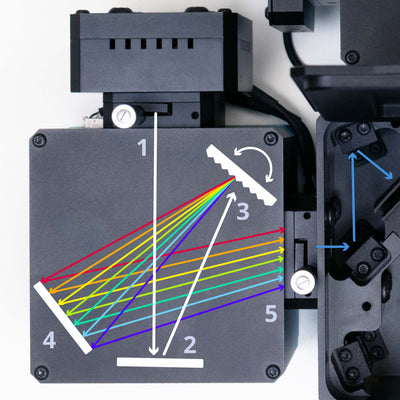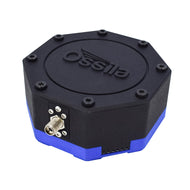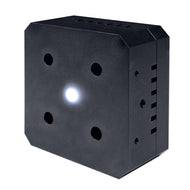Monochromator
Lab Equipment, SpectroscopyFast and Precise Wavelength Selection with <1 nm Accuracy
Low price grating monochromator, 100 mm focal length & fast acquisition rate (1000 nm/s)
Overview | How Monochromators Work | Specifications | Monochromator vs. Spectrometer | Features | Gallery
Choosing A Monochoromator | Accessories
The Ossila Monochromator is compact, low cost, and can be reliably integrated into many optical setups. Select specific wavelengths between 380 – 1000 nm with <1 nm accuracy, or quickly scan through this spectral range with impressive scanning rates of up to 1000 nm/s. Easily control this system with free downloadable Monochromator Console software or with serial commands.
Choose a specific excitation wavelengths for fluorescence measurements, isolate and measure specific emission signals, or simply improve the sensitivity and accuracy of absorbance measurements with just the touch of a button. Compatible with optical rail systems, the Monochromator can be integrated into any optics bench.
Whatever your experimental needs, use the Ossila Monochromator to source tunable monochromatic light.
Compact Size
And compatible with optical rail systems
High-Speed Scanning
For fast data acquisition
Easy to Use
Control with free software
Smart Design
Using Czerny-Turner configuration
How Does A Monochromator Work
A monochromator splits light into its component spectrum, then isolates and transmits a specific narrow band of wavelengths. These systems can be used to select wavelengths for specific excitations, or to scan through a range of wavelengths individually.
A grating monochromator uses a diffraction grating to disperse light. Then, an adjustable slit is used to select narrow band of wavelengths to transmit as the output signal.
A Czerny-Turner grating monochromator, like the Ossila Monochromator, works according to the following configuration:
- Broadband light enters through the entrance slit
- A concave mirror focuses the light onto a diffraction grating
- The diffraction grating disperses the light towards a second mirror.
- A second mirror redirects the disperse light towards the exit slit
- Depending on the angle of the grating, a different portion of the disperse light is focussed through the exit slit.
Specifications*
| Wavelength Range | 380 nm – 1000 nm |
|---|---|
| Wavelength Accuracy | <1 nm |
| Wavelength Repeatability | <0.1 nm |
| Focal Length | 100 mm |
| f Number | f/4 |
| Configuration | Crossed Czerny-Turner |
| Slit Type | Manual |
| Possible Slit Sizes | 50 μm – 6 mm (W) x 10 mm (H) |
| Weight | 1.1 kg |
| Dimensions (W x D x H) | 114 mm x 114 mm x 100 mm |
*The Ossila Monochromator is currently under active development. Some features and specifications are subject to refinement as we approach our full launch.
Monochromators vs Spectrometers
Monochromators and spectrometers both use diffraction gratings or prisms to split light into its component wavelengths, but they serve different primary purposes.
Monochromators select and output a single beam of light with a narrow wavelength range. These systems are used within spectrofluorometers or within optical measurement systems, enabling more accurate measurements than spectrometers. In contrast, spectrometers are designed to measure the intensity of all wavelengths simultaneously. In spectrometers both diffraction grating and detector are housed in one unit. A stationary grating directs dispersed light towards a charge-coupled device (CCD) array. Each pixel corresponds to a different wavelength, so it measures an entire spectrum at once. These systems measure spectra more quickly, but with lower resolution.
Monochromator Features
High Scanning Speed
Rapid sample analysis with scanning speeds up to 1000 nm/s.
Quickly scan through a wide spectral range (380 – 1000 nm) while maintaining high accuracy and precision.
Compact and Low Cost
Integrate the monochromator into your custom setup thanks to the small footprint (140 mm x 140 mm x 100 mm).
Designed to be affordable, effective and compatible with optical rail systems.
Reduced Noise for Accurate Measurements
Select specific wavelengths with 1 nm accuracy.
The Czerny-Turner optical configuration with single entrance and exit slit reduces noise from unwanted reflections and multiple dispersions.
Easy-to-Use Software
Control the monochromator with free software. Simply plug in and select specific wavelengths or scan through a desired wavelength range.
The system can be controlled with serial commands.
Monochromator Gallery
Choosing A Monochromators: Efficiency, Sensitivity and Resolution
An efficient monochromator requires a high diffraction grating dispersion and grating efficiency in the appropriate wavelength range.
-
Grating Dispersion
(Measured in nm/mm) This is a property of diffraction gratings, representing the physical distance different wavelengths of light are dispersed by. With higher grating dispersions, light will be separated at larger angles, leading to greater physical separation. Higher grating dispersion increases a monochromators resolution.
-
Grating Efficiency
(Plotted as efficiency over wavelength) Diffraction gratings will have different efficiencies at different wavelengths. By measuring the intensity of diffracted light over a wide wavelength range, manufacturers create a grating efficiency curve. Using this grating efficiency curve, monochromator manufacturers can choose diffraction gratings with the highest efficiencies in their desired spectral region.
What is Stray Light?
Stray light refers to any light outside of the chosen wavelength range which escapes with the output signal. This contributes to the noise of a spectroscopy measurement. Stray light should be as low as possible in any monochromator design. It depends on many factors including monochromator bandpass, optical alignment and detector sensitivity.
Stray light is an important consideration in monochromators, especially when conducting fluorescence spectroscopy. In fluorescence measurements, only a small proportion of the excitation signal is absorbed by fluorophores, and the subsequent photoluminescence quantum yield is rarely 100%. Therefore, fluorescence signals could be 1000 x less intense than initial excitation signals, so even a small amount of stray light can cause unreliable measurements.
Monochromator Sensitivity vs. Resolution
Adjustable width slits allow users to control the light entering and exiting the monochromator. There is a trade off when optimizing slit width. Light intensity allowed through a slit is proportional to slit area, so increasing slit width increases signal intensity and signal to noise ratio, so improves instrument sensitivity. This can be useful for low-signal measurements.
However, increasing slit width (especially at the exit slit) will decrease measurement resolution, as it allows a larger range of wavelengths to exit the monochromator. To increase measurement resolution requires a smaller slit width.
Achieving high resolution and sensitivity is a balancing act. Depending on your measurement requirements and your sample , you will need to optimize your slit widths to maximize resolution and sensitivity. Therefore, it is important to have a wide available slit width range for both the incident and output light.
Accessories and Related Products










